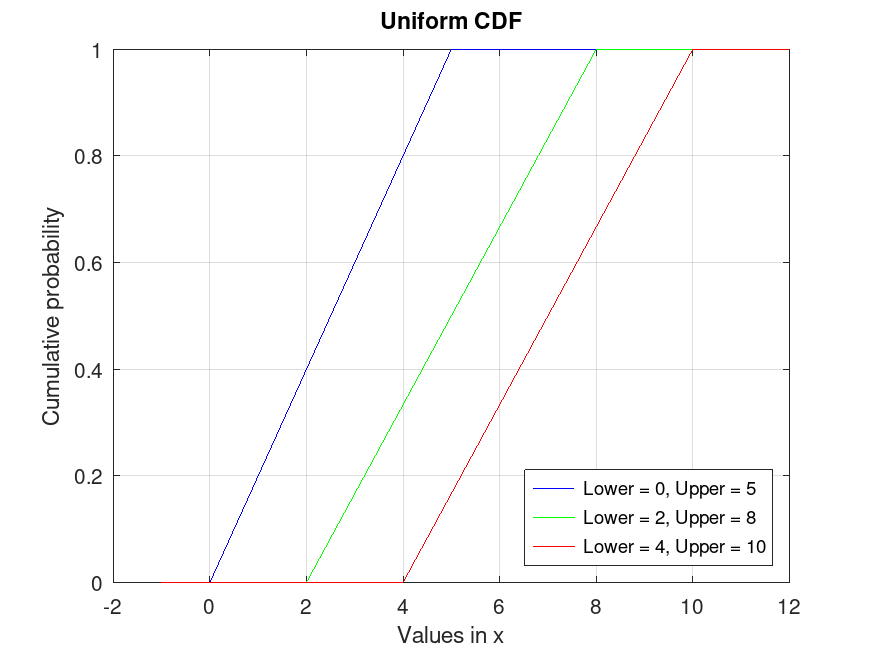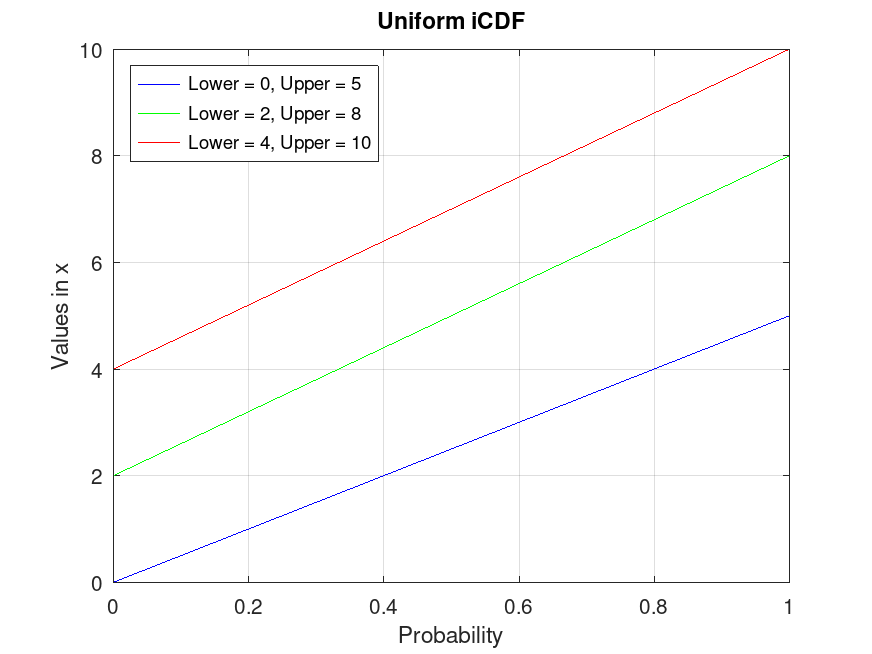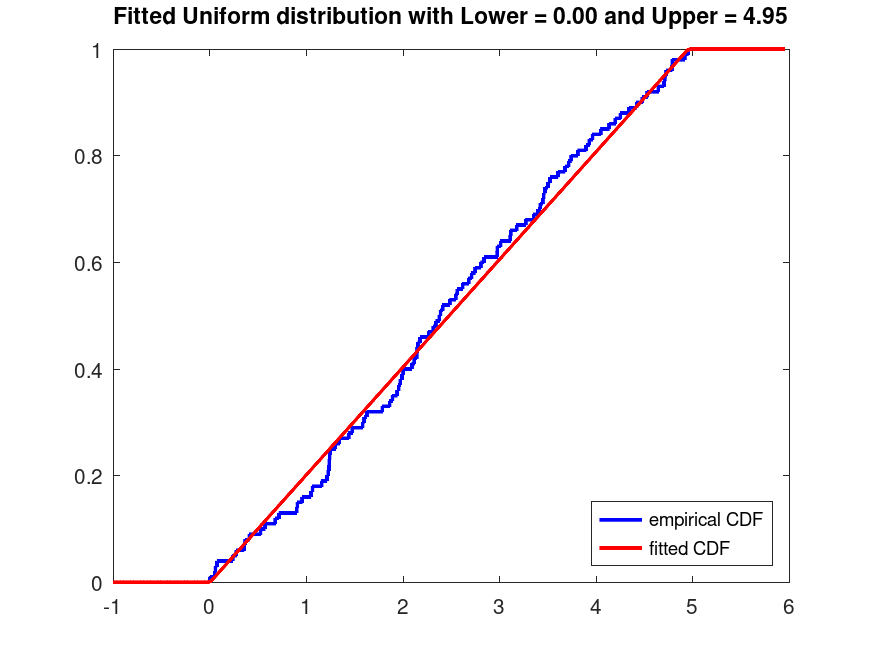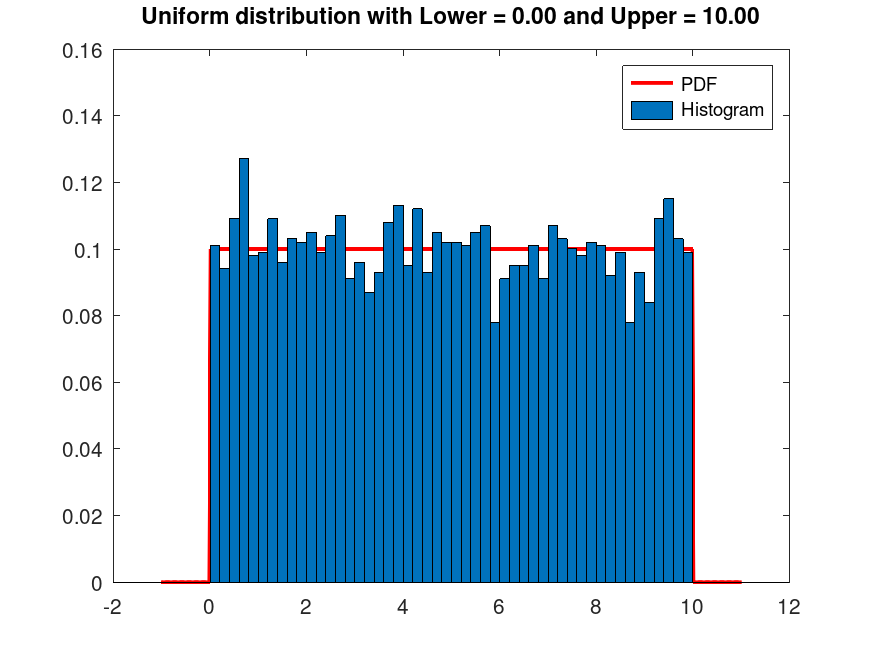Categories &
Functions List
- BetaDistribution
- BinomialDistribution
- BirnbaumSaundersDistribution
- BurrDistribution
- ExponentialDistribution
- ExtremeValueDistribution
- GammaDistribution
- GeneralizedExtremeValueDistribution
- GeneralizedParetoDistribution
- HalfNormalDistribution
- InverseGaussianDistribution
- LogisticDistribution
- LoglogisticDistribution
- LognormalDistribution
- LoguniformDistribution
- MultinomialDistribution
- NakagamiDistribution
- NegativeBinomialDistribution
- NormalDistribution
- PiecewiseLinearDistribution
- PoissonDistribution
- RayleighDistribution
- RicianDistribution
- tLocationScaleDistribution
- TriangularDistribution
- UniformDistribution
- WeibullDistribution
- betafit
- betalike
- binofit
- binolike
- bisafit
- bisalike
- burrfit
- burrlike
- evfit
- evlike
- expfit
- explike
- gamfit
- gamlike
- geofit
- gevfit_lmom
- gevfit
- gevlike
- gpfit
- gplike
- gumbelfit
- gumbellike
- hnfit
- hnlike
- invgfit
- invglike
- logifit
- logilike
- loglfit
- logllike
- lognfit
- lognlike
- nakafit
- nakalike
- nbinfit
- nbinlike
- normfit
- normlike
- poissfit
- poisslike
- raylfit
- rayllike
- ricefit
- ricelike
- tlsfit
- tlslike
- unidfit
- unifit
- wblfit
- wbllike
- betacdf
- betainv
- betapdf
- betarnd
- binocdf
- binoinv
- binopdf
- binornd
- bisacdf
- bisainv
- bisapdf
- bisarnd
- burrcdf
- burrinv
- burrpdf
- burrrnd
- bvncdf
- bvtcdf
- cauchycdf
- cauchyinv
- cauchypdf
- cauchyrnd
- chi2cdf
- chi2inv
- chi2pdf
- chi2rnd
- copulacdf
- copulapdf
- copularnd
- evcdf
- evinv
- evpdf
- evrnd
- expcdf
- expinv
- exppdf
- exprnd
- fcdf
- finv
- fpdf
- frnd
- gamcdf
- gaminv
- gampdf
- gamrnd
- geocdf
- geoinv
- geopdf
- geornd
- gevcdf
- gevinv
- gevpdf
- gevrnd
- gpcdf
- gpinv
- gppdf
- gprnd
- gumbelcdf
- gumbelinv
- gumbelpdf
- gumbelrnd
- hncdf
- hninv
- hnpdf
- hnrnd
- hygecdf
- hygeinv
- hygepdf
- hygernd
- invgcdf
- invginv
- invgpdf
- invgrnd
- iwishpdf
- iwishrnd
- jsucdf
- jsupdf
- laplacecdf
- laplaceinv
- laplacepdf
- laplacernd
- logicdf
- logiinv
- logipdf
- logirnd
- loglcdf
- loglinv
- loglpdf
- loglrnd
- logncdf
- logninv
- lognpdf
- lognrnd
- mnpdf
- mnrnd
- mvncdf
- mvnpdf
- mvnrnd
- mvtcdf
- mvtpdf
- mvtrnd
- mvtcdfqmc
- nakacdf
- nakainv
- nakapdf
- nakarnd
- nbincdf
- nbininv
- nbinpdf
- nbinrnd
- ncfcdf
- ncfinv
- ncfpdf
- ncfrnd
- nctcdf
- nctinv
- nctpdf
- nctrnd
- ncx2cdf
- ncx2inv
- ncx2pdf
- ncx2rnd
- normcdf
- norminv
- normpdf
- normrnd
- plcdf
- plinv
- plpdf
- plrnd
- poisscdf
- poissinv
- poisspdf
- poissrnd
- raylcdf
- raylinv
- raylpdf
- raylrnd
- ricecdf
- riceinv
- ricepdf
- ricernd
- tcdf
- tinv
- tpdf
- trnd
- tlscdf
- tlsinv
- tlspdf
- tlsrnd
- tricdf
- triinv
- tripdf
- trirnd
- unidcdf
- unidinv
- unidpdf
- unidrnd
- unifcdf
- unifinv
- unifpdf
- unifrnd
- vmcdf
- vminv
- vmpdf
- vmrnd
- wblcdf
- wblinv
- wblpdf
- wblrnd
- wienrnd
- wishpdf
- wishrnd
- adtest
- anova1
- anova2
- anovan
- bartlett_test
- barttest
- binotest
- chi2gof
- chi2test
- correlation_test
- fishertest
- friedman
- hotelling_t2test
- hotelling_t2test2
- kruskalwallis
- kstest
- kstest2
- levene_test
- manova1
- mcnemar_test
- multcompare
- ranksum
- regression_ftest
- regression_ttest
- runstest
- sampsizepwr
- signrank
- signtest
- tiedrank
- ttest
- ttest2
- vartest
- vartest2
- vartestn
- ztest
- ztest2
Class Definition: UniformDistribution
statistics: UniformDistribution
Continuous uniform probability distribution object.
A UniformDistribution object consists of parameters, a model
description, and sample data for a uniform probability distribution.
The uniform distribution is a continuous probability distribution that models random variables that are equally likely to take any value within a specified interval defined by the lower limit Lower and upper limit Upper.
There are several ways to create a UniformDistribution object.
- Fit a distribution to data using the
fitdistfunction. - Create a distribution with fixed parameter values using the
makedistfunction. - Use the constructor
UniformDistribution (Lower, Upper)to create a uniform distribution with fixed parameter values Lower and Upper.
It is highly recommended to use fitdist and makedist
functions to create probability distribution objects, instead of the class
constructor.
Further information about the continuous uniform distribution can be found at https://en.wikipedia.org/wiki/Continuous_uniform_distribution
See also: fitdist, makedist, unifcdf, unifinv, unifpdf, unifrnd, unifit, unifstat
Source Code: UniformDistribution
Properties
A scalar value characterizing the lower bound of the uniform
distribution. You can access the Lower property using dot
name assignment.
Example: 1
## Create a Uniform distribution with default parameters
pd = makedist ("Uniform", "Lower", 2, "Upper", 5);
## Query parameter 'Lower' (lower limit parameter)
pd.Lower
## Set parameter 'Lower'
pd.Lower = 2
## Use this to initialize or modify the lower bound of a Uniform distribution.
## The lower limit must be a real scalar less than the upper limit, useful for
## defining the range of a uniform variable, such as random measurements or time intervals.
ans = 2
pd =
UniformDistribution
Uniform distribution (continuous)
Lower = 2
Upper = 5
|
Example: 2
## Create a Uniform distribution object by calling its constructor
pd = UniformDistribution (1, 10)
## Query parameter 'Lower'
pd.Lower
## This demonstrates direct construction with a specific lower limit, ideal for
## modeling data uniformly distributed over a known interval, such as random selections.
pd =
UniformDistribution
Uniform distribution (continuous)
Lower = 1
Upper = 10
ans = 1
|
A scalar value characterizing the upper bound of the uniform
distribution. You can access the Upper property using dot
name assignment.
Example: 1
## Create a Uniform distribution with default parameters
pd = makedist ("Uniform")
## Query parameter 'Upper' (upper limit parameter)
pd.Upper
## Set parameter 'Upper'
pd.Upper = 8
## Use this to initialize or modify the upper bound of a Uniform distribution.
## The upper limit must be a real scalar greater than the lower limit, controlling
## the range of the distribution.
pd =
UniformDistribution
Uniform distribution (continuous)
Lower = 0
Upper = 1
ans = 1
pd =
UniformDistribution
Uniform distribution (continuous)
Lower = 0
Upper = 8
|
Example: 2
## Create a Uniform distribution object by calling its constructor
pd = UniformDistribution (1, 10)
## Query parameter 'Upper'
pd.Upper
## This shows how to set the upper limit directly via the constructor, useful
## for defining the maximum value in a uniform distribution.
pd =
UniformDistribution
Uniform distribution (continuous)
Lower = 1
Upper = 10
ans = 10
|
A character vector specifying the name of the probability distribution object. This property is read-only.
A scalar integer value specifying the number of parameters characterizing the probability distribution. This property is read-only.
A cell array of character vectors with each element containing the name of a distribution parameter. This property is read-only.
A cell array of character vectors with each element containing a short description of a distribution parameter. This property is read-only.
A numeric vector containing the values of the distribution
parameters. This property is read-only. You can change the distribution
parameters by assigning new values to the Lower and Upper
properties.
A numeric vector specifying the truncation interval for the
probability distribution. First element contains the lower boundary,
second element contains the upper boundary. This property is read-only.
You can only truncate a probability distribution with the
truncate method.
A logical scalar value specifying whether a probability distribution is truncated or not. This property is read-only.
Methods
UniformDistribution: p = cdf (pd, x)
UniformDistribution: p = cdf (pd, x,
"upper")
p = cdf (pd, x) computes the CDF of the
probability distribution object, pd, evaluated at the values in
x.
p = cdf (…, returns the complement of
the CDF of the probability distribution object, pd, evaluated at
the values in x.
"upper")
Example: 1
## Plot various CDFs from the Uniform distribution
x = -1:0.01:12;
pd1 = makedist ("Uniform", "Lower", 0, "Upper", 5);
pd2 = makedist ("Uniform", "Lower", 2, "Upper", 8);
pd3 = makedist ("Uniform", "Lower", 4, "Upper", 10);
p1 = cdf (pd1, x);
p2 = cdf (pd2, x);
p3 = cdf (pd3, x);
plot (x, p1, "-b", x, p2, "-g", x, p3, "-r")
grid on
legend ({"Lower = 0, Upper = 5", "Lower = 2, Upper = 8", "Lower = 4, Upper = 10"}, ...
"location", "southeast")
title ("Uniform CDF")
xlabel ("Values in x")
ylabel ("Cumulative probability")
## Use this to compute and visualize the cumulative distribution function
## for different Uniform distributions, showing how probability accumulates
## over the defined interval, useful in probability assessments or simulations.
|

UniformDistribution: x = icdf (pd, p)
x = icdf (pd, p) computes the quantile (the
inverse of the CDF) of the probability distribution object, pd,
evaluated at the values in p.
Example: 1
## Plot various iCDFs from the Uniform distribution
p = 0.001:0.001:0.999;
pd1 = makedist ("Uniform", "Lower", 0, "Upper", 5);
pd2 = makedist ("Uniform", "Lower", 2, "Upper", 8);
pd3 = makedist ("Uniform", "Lower", 4, "Upper", 10);
x1 = icdf (pd1, p);
x2 = icdf (pd2, p);
x3 = icdf (pd3, p);
plot (p, x1, "-b", p, x2, "-g", p, x3, "-r")
grid on
legend ({"Lower = 0, Upper = 5", "Lower = 2, Upper = 8", "Lower = 4, Upper = 10"}, ...
"location", "northwest")
title ("Uniform iCDF")
xlabel ("Probability")
ylabel ("Values in x")
## This demonstrates the inverse CDF (quantiles) for Uniform distributions,
## useful for finding values corresponding to given probabilities, such as
## thresholds in uniform sampling.
|

UniformDistribution: r = iqr (pd)
r = iqr (pd) computes the interquartile range of the
probability distribution object, pd.
Example: 1
## Compute the interquartile range for a Uniform distribution
pd = makedist ("Uniform", "Lower", 0, "Upper", 10)
iqr_value = iqr (pd)
## Use this to calculate the interquartile range, which measures the spread
## of the middle 50% of the distribution, helpful for understanding central
## variability in uniformly distributed data.
pd =
UniformDistribution
Uniform distribution (continuous)
Lower = 0
Upper = 10
iqr_value = 5
|
UniformDistribution: m = mean (pd)
m = mean (pd) computes the mean of the probability
distribution object, pd.
Example: 1
## Compute the mean for different Uniform distributions
pd1 = makedist ("Uniform", "Lower", 0, "Upper", 5);
pd2 = makedist ("Uniform", "Lower", 2, "Upper", 8);
mean1 = mean (pd1)
mean2 = mean (pd2)
## This shows how to compute the expected value for Uniform distributions
## with different bounds, representing the average value within the interval.
mean1 = 2.5000
mean2 = 5
|
UniformDistribution: m = median (pd)
m = median (pd) computes the median of the probability
distribution object, pd.
Example: 1
## Compute the median for different Uniform distributions
pd1 = makedist ("Uniform", "Lower", 0, "Upper", 5);
pd2 = makedist ("Uniform", "Lower", 2, "Upper", 8);
median1 = median (pd1)
median2 = median (pd2)
## Use this to find the median value, which splits the distribution
## into two equal probability halves, useful for central tendency in uniform data.
median1 = 2.5000
median2 = 5
|
UniformDistribution: y = pdf (pd, x)
y = pdf (pd, x) computes the PDF of the
probability distribution object, pd, evaluated at the values in
x.
Example: 1
## Plot various PDFs from the Uniform distribution
x = -1:0.01:12;
pd1 = makedist ("Uniform", "Lower", 0, "Upper", 5);
pd2 = makedist ("Uniform", "Lower", 2, "Upper", 8);
pd3 = makedist ("Uniform", "Lower", 4, "Upper", 10);
y1 = pdf (pd1, x);
y2 = pdf (pd2, x);
y3 = pdf (pd3, x);
plot (x, y1, "-b", x, y2, "-g", x, y3, "-r")
grid on
legend ({"Lower = 0, Upper = 5", "Lower = 2, Upper = 8", "Lower = 4, Upper = 10"}, ...
"location", "northeast")
title ("Uniform PDF")
xlabel ("Values in x")
ylabel ("Probability density")
## This visualizes the probability density function for Uniform distributions,
## showing the constant likelihood within the defined interval.
|

UniformDistribution: plot (pd)
UniformDistribution: plot (pd, Name, Value)
UniformDistribution: h = plot (…)
plot (pd) plots a probability density function (PDF) of the
probability distribution object pd. If pd contains data,
which have been fitted by fitdist, the PDF is superimposed over a
histogram of the data.
plot (pd, Name, Value) specifies additional
options with the Name-Value pair arguments listed below.
| Name | Value | |
|---|---|---|
"PlotType" | A character vector specifying the plot
type. "pdf" plots the probability density function (PDF). When
pd is fit to data, the PDF is superimposed on a histogram of the
data. "cdf" plots the cumulative density function (CDF). When
pd is fit to data, the CDF is superimposed over an empirical CDF.
"probability" plots a probability plot using a CDF of the data
and a CDF of the fitted probability distribution. This option is
available only when pd is fitted to data. | |
"Discrete" | A logical scalar to specify whether to
plot the PDF or CDF of a discrete distribution object as a line plot or a
stem plot, by specifying false or true, respectively. By
default, it is true for discrete distributions and false
for continuous distributions. When pd is a continuous distribution
object, option is ignored. | |
"Parent" | An axes graphics object for plot. If
not specified, the plot function plots into the current axes or
creates a new axes object if one does not exist. |
h = plot (…) returns a graphics handle to the plotted
objects.
Example: 1
## Create a Uniform distribution with fixed parameters Lower = 0 and Upper = 5
## and plot its PDF.
pd = makedist ("Uniform", "Lower", 0, "Upper", 5)
plot (pd)
title ("Uniform distribution with Lower = 0 and Upper = 5")
## Use this to visualize the PDF of a Uniform distribution with fixed bounds,
## useful for understanding the uniform probability density.
pd =
UniformDistribution
Uniform distribution (continuous)
Lower = 0
Upper = 5
|

Example: 2
## Generate a data set of 100 random samples from a Uniform distribution
## with parameters Lower = 0 and Upper = 5. Fit a Uniform distribution to this
## data and plot its CDF superimposed over an empirical CDF.
rand ("seed", 21);
pd_fixed = makedist ("Uniform", "Lower", 0, "Upper", 5);
data = random (pd_fixed, 100, 1);
lower_hat = min (data);
upper_hat = max (data);
[f_empirical, x_empirical] = ecdf (data);
stairs (x_empirical, f_empirical, 'b', 'LineWidth', 2);
hold on;
x = linspace (lower_hat - 1, upper_hat + 1, 200);
y = (x - lower_hat) / (upper_hat - lower_hat);
y(x < lower_hat) = 0;
y(x > upper_hat) = 1;
plot (x, y, 'r-', 'LineWidth', 2);
% Title and legend
txt = "Fitted Uniform distribution with Lower = %0.2f and Upper = %0.2f";
title (sprintf (txt, lower_hat, upper_hat));
legend ({"empirical CDF", "fitted CDF"}, "location", "southeast");
hold off;
## Use this to visualize the fitted CDF compared to the empirical CDF of the
## data, useful for assessing model fit.
|

UniformDistribution: r = random (pd)
UniformDistribution: r = random (pd, rows)
UniformDistribution: r = random (pd, rows, cols, …)
UniformDistribution: r = random (pd, [sz])
r = random (pd) returns a random number from the
distribution object pd.
When called with a single size argument, unifrnd returns a square
matrix with the dimension specified. When called with more than one
scalar argument, the first two arguments are taken as the number of rows
and columns and any further arguments specify additional matrix
dimensions. The size may also be specified with a row vector of
dimensions, sz.
Example: 1
## Generate random samples from a Uniform distribution
pd = makedist ("Uniform", "Lower", 0, "Upper", 5)
rand ("seed", 21);
samples = random (pd, 500, 1);
hist (samples, 50)
title ("Histogram of 500 random samples from Uniform(Lower=0, Upper=5)")
xlabel ("Values in x")
ylabel ("Frequency")
## This generates random samples from a Uniform distribution, useful
## for simulating data with equal probability over a fixed interval.
pd =
UniformDistribution
Uniform distribution (continuous)
Lower = 0
Upper = 5
|

UniformDistribution: s = std (pd)
s = std (pd) computes the standard deviation of the
probability distribution object, pd.
Example: 1
## Compute the standard deviation for a Uniform distribution
pd = makedist ("Uniform", "Lower", 0, "Upper", 10)
std_value = std (pd)
## Use this to calculate the standard deviation, which measures the variability
## within the uniform interval.
pd =
UniformDistribution
Uniform distribution (continuous)
Lower = 0
Upper = 10
std_value = 2.8868
|
UniformDistribution: t = truncate (pd, lower, upper)
t = truncate (pd, lower, upper) returns a
probability distribution t, which is the probability distribution
pd truncated to the specified interval with lower limit,
lower, and upper limit, upper. If pd is fitted to data
with fitdist, the returned probability distribution t is not
fitted, does not contain any data or estimated values, and it is as it
has been created with the makedist function, but it includes the
truncation interval.
Example: 1
## Plot the PDF of a Uniform distribution, with parameters Lower = 0
## and Upper = 10, truncated at [2, 8] intervals. Generate 10000 random
## samples from this truncated distribution and superimpose a histogram scaled
## accordingly
pd = makedist ("Uniform", "Lower", 0, "Upper", 10)
t = truncate (pd, 2, 8)
rand ("seed", 21);
data = random (t, 10000, 1);
[counts, centers] = hist (data, 50);
bin_width = centers(2) - centers(1);
bar (centers, counts / (sum (counts) * bin_width), 1);
hold on;
## Plot histogram and truncated PDF
x = linspace (0.5, 5, 500);
y = pdf (t, x);
plot (x, y, "r", "linewidth", 2);
title ("Uniform distribution (Lower = 0, Upper = 10) truncated at [2, 8]")
legend ("Truncated PDF", "Histogram")
## This demonstrates truncating a Uniform distribution to a specific
## range and visualizing the resulting distribution with random samples.
pd =
UniformDistribution
Uniform distribution (continuous)
Lower = 0
Upper = 10
t =
UniformDistribution
Uniform distribution (continuous)
Lower = 0
Upper = 10
Truncated to the interval [2, 8]
|

UniformDistribution: v = var (pd)
v = var (pd) computes the variance of the
probability distribution object, pd.
Example: 1
## Compute the variance for a Uniform distribution
pd = makedist ("Uniform", "Lower", 0, "Upper", 10)
var_value = var (pd)
## Use this to calculate the variance, which quantifies the spread of the
## values within the uniform interval.
pd =
UniformDistribution
Uniform distribution (continuous)
Lower = 0
Upper = 10
var_value = 8.3333
|
Examples
pd = makedist ("Uniform", "Lower", 0, "Upper", 10);
rand ("seed", 21);
data = random (pd, 5000, 1);
x = linspace (pd.Lower - 1, pd.Upper + 1, 500);
y = pdf (pd, x);
plot (x, y, 'r-', 'LineWidth', 2);
hold on;
[counts, centers] = hist (data, 50);
bin_width = centers(2) - centers(1);
normalized_counts = counts / (sum (counts) * bin_width);
bar (centers, normalized_counts, 1);
msg = "Uniform distribution with Lower = %0.2f and Upper = %0.2f";
title (sprintf (msg, pd.Lower, pd.Upper));
legend ("PDF", "Histogram", "location", "northeast");
hold off; |
